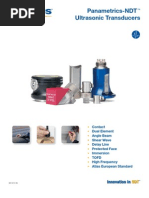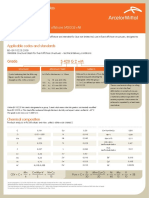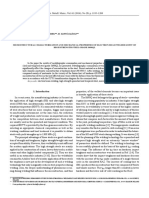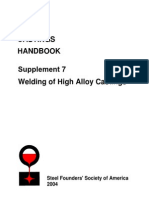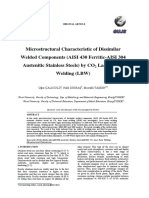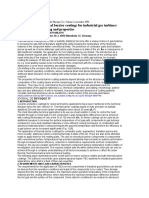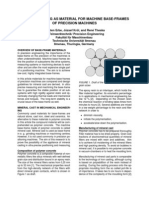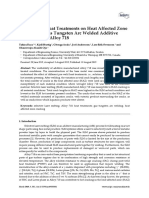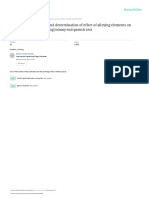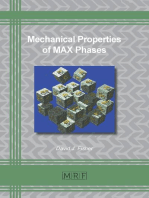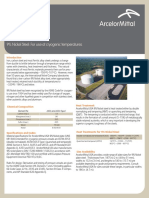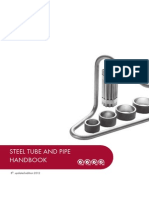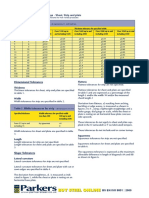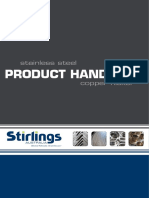9 Ni
9 Ni
Uploaded by
Adisak AumpiemCopyright:
Available Formats
9 Ni
9 Ni
Uploaded by
Adisak AumpiemCopyright
Available Formats
Share this document
Did you find this document useful?
Is this content inappropriate?
Copyright:
Available Formats
9 Ni
9 Ni
Uploaded by
Adisak AumpiemCopyright:
Available Formats
Materials Sciences and Applications, 2013, 4, 198-204
doi:10.4236/msa.2013.43024 Published Online March 2013 (http://www.scirp.org/journal/msa)
The Influence of Welding Parameters on Brittle Fracture
of Liquefied Natural Gas Storage Tank Welded Joint
Abd El Fattah Mustafa Khourshid, Mohamed Ahmed Ghanem
Production Engineering and Mechanical Design Department, Faculty of Engineering, Tanta University, Tanta, Egypt.
Email: engmghanem66@yahoo.com
Received December 9th, 2012; revised January 11th, 2013; accepted February 9th, 2013
ABSTRACT
Many applications operate at sufficiently low temperature conditions where most structural steels become very brittle
and, therefore, unsuitable for use in safety-critical structures. So the materials used in the vessels or storage tanks which
keep the natural gas at liquefaction temperatures need to remain ductile and crack resistant with a high level of safety.
The material also needs to have high strength in order to reduce the wall thickness of the container and it must permit
welding without any risk of brittle fracture. 9% Ni steel plates are one of most common used materials in the LNG
storage tank application. However, the welding procedure for 9% Ni steel plates requires high level of skills of welding
that is strictly controlled welding parameter for balancing avoidance of cold and hot cracking and maintenance of high
strength. Mechanical properties are important characteristics of the weldment that must confirm to the application feasi-
bility as well as functional requirements of the welded joint. The only way to enhanced the mechanical properties of
welded joint by controlling the parameters of using welding process. From the main variables of the arc welding process
are the heat input and interpass temperature where the two variables control the thermal cycle of welding process. The
experiment show that for thin test specimen with thickness ≤ 14 mm, the heat input range from 1.4 to 2 KJ/mm and con-
trolling interpass temperature within 80˚C give high tensile strength with improving the toughness properties of welded
joint and reduce the probability of brittle fracture happened by increase the ductility and reduce the yield strength and
increased the transition temperature.
Keywords: 9% Ni Steel Plate; LNG Tank; Heat Input; Mechanical Properties; Welding Process and Brittle Fracture
1. Introduction grained structure of tough nickel-ferrite free from em-
brittling carbide networks. The optimum microstructure
Metallurgical characteristics of the weld metal as well as
and mechanical properties are obtained by a carefully
heat affected zone (HAZ) are very important because this
controlled heat-treatment in the production of the steel
directly influence the weld mechanical properties and [2].
joint performances. It is well known that the micro These unique properties of the 9% Ni steel plates have
structure of the weld metal is different from the micro- resulted from the microstructure where consist mainly
structure of base metal as well as HAZ. The weld micro- from fine martensite and from 5% - 15% retained austen-
structures, however, are somewhat different with respect ite. This microstructure is existing due to quenching and
to distributions of martensite and austenite, their amounts, tempering [3-5].
grain sizes etc. depending upon the welding conditions The welding is widely used in construction these ap-
adopted. From more important application is (LNG) that plications, controlling the parameters which affect the
will be liquefy at −163˚C and is therefore stored or trans- weldability of 9% Ni steels is critical to the successful
ported around −170˚C. At this low temperature quenched implementation of these engineering materials [6].
and tempered 9% nickel steels have the fracture tough- The weldability of 9% nickel steel is excellent and the
ness and crack arrest properties required for safe con- steel is not susceptible to cracking and shows little or no
struction of tanks and vessels [1]. detoriation of the properties by the heat inputs normally
Combination of high strength and good toughness is used during the welding with procedures. Heat input
essential for the steels used in liquefied natural gas epi- should not exceed 3 kJ/mm and interpass temperature
cally there is a high risk assessment of probability of must be limited to max 100˚C - 150˚C [1,2].
leakage done. The excellent low temperature notch im- The strength and toughness required for the weld
pact properties of 9% nickel steels arise from the fine metal differs greatly depending upon the application for
Copyright © 2013 SciRes. MSA
The Influence of Welding Parameters on Brittle Fracture of Liquefied Natural Gas Storage Tank Welded Joint 199
which the structure is employed and according to the drogen diffusion from the weld and is a major factor
type of steel and welding materials. Depending upon the when avoiding hydrogen cracking [16].
welding processes the thermal conditions differ greatly As interpass temperature is increased, the main micro-
up to the time when the weld metal is formed, solidifies structural effect is that the amount of columnar structure
and is cooled. The properties will differ according to the within a reheated weld bead is reduced and an increase in
difference in welding conditions and especial without the the amount of re-austerities and tempered areas is seen
postweld heat treatment (PWHT) even when identical especially within the central beads of a welded joint. Lit-
welding processes and welding materials are employed. tle effects are seen on the cross sectional area of each
[7]. weld bead deposited with increase in interpass tempera-
Both strength and toughness are critical properties ture but the proportion of recrystallised area increases
since failure may occur through either ductile rupture or [17]. By eliminating the columnar microstructure, hard-
fracture. The combination is important since strength and ness becomes more uniform and is reduced. There is also
toughness have an inverse relation to one another; an a reduction in strength by increasing interpass tempera-
increase in strength at given temperature almost invaria- ture however toughness at low temperatures increases.
bly leads to a decrease in fracture toughness. While there To conclude, control of welding parameters such as
is no reliable quantitative theory of the strength—tough- interpass temperature is important. The Recent work [18]
ness relation of structural alloys [8]. analyzed the variation of mechanical properties of high
For such inhomogeneous systems, measurement of the strength weld metals and concluded that variations in
toughness alone has little meaning if it is not related to yield strength were not alone due to compositional varia-
the tensile properties of the material system. It has been tions, but also to process parameters such as the weld
demonstrated that the apparent fracture toughness of the metal interpass temperature.
same HAZ microstructure can be changed dramatically Previous investigations have demonstrated the effec-
by just changing the tensile properties in the adjacent tive welding parameters on both of weld metal and heat
weld metal [9]. affected zones as a function of the cooling rate from peak
The cooling rate is a primary factor that determines the temperature [19-22]. Consequently, it concern on the
final metallurgical structure of the weld and heat affected improving of the toughness properties and the micro-
zone (HAZ), and is especially important with heat- structure of welded joint for thickness plate is more
treated steels. Especially during welding quenched and than 20 mm to be in good condition by using heat input
tempered steels, the slow cooling rates (resulting from in the range from 1 - 3 KJ/mm and the interpass tem-
high heat inputs) can soften the material adjacent to the perature no more 150˚C.
weld, reducing the load-carrying capacity of the connec- More recent work identified that heat input affects on
tion. [10]. the microstructure to improve the toughness of welded
Weldment toughness tends to deteriorate with increase joint by controlling the cooling rates and creates types of
in welding heat input. It is said that this tendency is ferrite phase and the effect of creation of ferrite types on
caused by the austenite grain growth at the heat-affected the tensile strength of welded joint [23-25].
zone (HAZ) during the welding thermal cycle [11,12]. However, this paper concern on heat input and inter-
Although With the increase of heat input, the impact pass temperature as the main factors for affecting the
toughness of weld zone and heat affected zone decrease, embrittlement of weld joints, when the heat input is in
whereas the tensile strength of the weld joints does not suitable range and controlling the interpass temperature
change at all [13]. the in order to improve the tensile strength and toughness
Under different weld heat inputs, the impact energy of properties of welded joint. By using shield metal arc
the HAZ has a larger difference, indicating a tendency welding process with heat input rang from 1.3 - 2.5
for a change in the fine structure of the HAZ. By control- KJ/mm, interpass temperature within 80˚C and test
ling weld heat input = 20 kJ/cm, the presence of carbide specimens of 9% Ni steel plate with thickness 6, 10 & 14
in the HAZ can be removed, and therefore the impact mm in vertical position.
toughness in this zone can be assured [10,11].
A specific maximum interpass temperature in welding 2. Experimental Procedure
procedure is sometimes required e.g., in order to avoid
2.1. Base Metal
hot cracking. In this case using a higher interpass tem-
perature will increase the time spent in the critical tem- The SA553 type 1 (9% Ni) steel is the used material for
perature range [14,15]. the liquefied natural gas (LNG) tank application. Its
This is also an issue with high strength steel weld met- microstructure content from martensite and retained
als but using a high interpass temperature normally plays austenite about (5% to 15% of structure size) as shown in
a more important role. Longer cooling times allows hy- (Figure 1), so this posses tensile strength range from 620
Copyright © 2013 SciRes. MSA
200 The Influence of Welding Parameters on Brittle Fracture of Liquefied Natural Gas Storage Tank Welded Joint
omy is also offered when using high recovery electrodes.
So by using SMAW as welding process, electrode E
NiCrFe4 with 2.5, 3.2 and 4.0 mm diameter to weld
SA553 type I steel test specimen with thickness 6, 10 and
14 mm. The interpass temperature controlled to no more
Figure 1. Present the microstructure of 9% Ni steel plate. than 80˚C with using low ampere and increasing the travel
speed to reduce the heat input.
to 850 MPa, impact energy at −196˚C reach to 100 J and The chemical composition and mechanical properties
more. [26]. of electrode ENiCrFe4 according to construction code
The test specimens are three crews with different standard and actual electrode certificates as shown in
thickness size 6, 10 and 14 mm thickness. The chemical Tables 3 and 4 [28].
and mechanical properties of 9% Ni steel plate according The geometry of welded joints as shown in (Figure 2)
to standards and the actual used according to material with different root opening according to the using of
certificate as shown in Tables 1 and 2 [27]. electrode diameter.
2.2. The Welding Process 2.3. The Mechanical Tests
Welding with stick electrodes however, is still a very Tensile tests have been done on 2 test samples from
flexible and viable process for welding under site condi- each welded joint .The test conducted according to
tions, all positions and all materials. A respected econ- the requirements of ASME IX [29] & ASME II part A,
Table 1. The chemical composition of 9% Ni steel.
Chemical composition (%)
Designation material
C Mn Si P S Ni Mo Cr Ti Cu Nb
A553 Type I (Standard) ≤0.13 ≤0.9 0.15 - 0.3 ≤0.035 ≤0.04 8.5 - 9.5 0.12 0.3 0.03 0.4 0.02
Test specimen
0.05 0.56 0.25 0.002 0.001 9.18 0.01 0.01 0.002 0.01 0.001
10 &14 mm THK
Test specimen
0.06 0.55 0.2 0.004 0.001 9.11 0.1 0.02 0.005 0.01 0.004
6 mm THK
Table 2. The mechanical properties of 9% Ni steel according standards and actual parent metal.
Mechanical properties
Material Specification
Y.S. [R.T*] (MPa) UTS [R.T*] (MPa) El.5d [20˚C] (%) Kv [−196˚C]
KvT ≥ 27 J
ASTM A553-1 ≥585 690 - 825 ≥20.0 Exp. > 0.381 mm
KvL ≥ 34 J
Test specimen 14/10 mm 665 715 44 KvT 205 - 226 - 236 1.7 - 1.72 - 1.76
Test specimen 6 mm 650 700 34 KvT 34 - 40 - 40 1.41 - 1.56 - 1.54
Table 3. The chemical compositions of ENiCrFe4 from code and actual values.
Chemical analysis %
Electrode designation
C Mn Fe P S Si Cu Ni Cr Nb Plus Ta Mo
ENiCrFe4 [21] standard 0.2 1.0 - 3.5 12 3 0.02 1 0.5 60 min 13 - 17 1.0 - 3.5 1.0 - 3.5
Weld metal 0.09 2.66 11.08 0.01 0.002 0.26 0.02 65.52 15.79 1.76 2.57
Table 4. The mechanical properties as standard and actual value of ENiCrFe4.
Mechanical properties
Electrode designation
Units standards Test temperature ˚C Tensile strength MPa Yield strength MPa Elongation (%)
EniCrFe4 (standard) Room temp. 660 (Min.) 360 (Min) 20 (Min.)
All weld metal 20˚C 689 419 41.7
Copyright © 2013 SciRes. MSA
The Influence of Welding Parameters on Brittle Fracture of Liquefied Natural Gas Storage Tank Welded Joint 201
Figure 3. The test sample of tensile stress.
Figure 2. The joint shape for different thickness (6, 10 & 14
mm).
SA370 [30] at room temperature and the samples
shape with dimensions as shown in (Figure 3).
Bend tests applied on 4 test samples from each
welded joint with keeping in the consideration the
requirements of ASME IX & ASME II part A, SA370
(2 test samples for root bends and 2 for face bend)
Charpy impact tests have been done in two zones of
welded joint weld metal and HAZ zones, 3 test sam-
ples for each zone according to ASME IX &ASME II
part A, SA370. The test temperature at −196˚C.
Lateral expansion test conducted according to
ASME IX & ASME II part A, SA370.
3. Results and Discussion Figure 4. The results of tensile strength test of 6 mm at dif-
ferent H.I.
3.1. Tension Tests
The tensile properties of the specimens obtained from the
welded joints with three different heat input levels are
shown in Figures 4-6. The tensile test results show that
different heat input levels are all above 690 MPa, which
is higher value of the material standards.
From the metallurgical aspects the microstructure of
solidification weld deposit can be determine by deter-
mine the time of cooling process between 800˚C to
500˚C. So from the heat transfer the next equation to
calculate the time of cooling from 800˚C to 500˚C de-
pend on the heat input have been used during the welding
of test specimen in 3 dimension.
t8 5 H.I 2 * K * π * 1 500 1 800 (1)
where Figure 5. The results of tensile strength test of 10 mm at
H.I = heat input different H.I.
K = coefficient of thermal conductivity (w/m.K).
According to the Equation (1) the time of cooling from the lower the interpass temperature effect with still low
800˚C/500˚C the time range is between 7.2 to 13.6 sec cooling time.
that related to H.I range from 13.4 to 25.2 KJ/mm. The initial weld passes preheat the base metal of mul-
Where the max tensile strength value exist with ap- tipass welds. The effects are greatest on the second pass.
plying welding with the lowest heat input, this is due to As the preheating conditions after the second pass are
higher cooling rate that is permission to austenite crystals stabilized, the resultant change in thermal cycle and cool-
structure to transform to martensite during welding so- ing rate is big significant.
lidification [25]. Although the fracture of test specimens done in weld
The different relation tensile strength and the heat in- metal zones in some test specimens but with strength
put is shown in Figure 5, where the development of ten- values higher than the minimum value of base metal.
sile strength value with increase the heat input because The compared results show that heat input has a big
Copyright © 2013 SciRes. MSA
202 The Influence of Welding Parameters on Brittle Fracture of Liquefied Natural Gas Storage Tank Welded Joint
Figure 6. The results of tensile strength test of 14 mm at
Figure 7. The impact tests results of 6 mm at different H.I.
different H.I.
effect on the tensile properties, with the increase of heat
input, the tensile strength of welding joint only increases
little.
3.2. Notch-Toughness Tests
The Charpy V notch impact toughness data obtained at
−196˚C from the WM and HAZ regions of three weld
joints welded with heat inputs levels are presented in
Figure 7 which the figure with underline shows the av-
erage value of the impact absorbed energy. It is clear that
the impact toughness of every zone of the weld joints
with three different heat input levels all satisfy the de-
mand of 27 J at −196˚C as required by standard, even Figure 8. The impact test results of 10 mm at different H.I.
when the heat input is in the range of 13.4 - 25.2 kJ/cm.
The results of toughness in HAZ and W.M zones were
increased as H.I decreased. Austenite-rich and ferrite-
rich bands are formed during socking because of the re-
distribution of element C, N and Ni. The austenite en-
riched of C, N and Ni is still stable [24].
On the other hand from Figures 8 and 9 the toughness
results increase as heat input increase to 2.1 KJ this is
shown as a results of HAZ & W.M zones and after that
the impact value decrease as H.I increase. This return to
increase in the cooling rate that increase the probability
of present lower binate phase.
The Max. toughness results exist in HAZ zone than the
results of W.M zone where the structure of HAZ is
mainly martensite and retained austenite affected by the
heat input only and W.M is mainly Ni base alloy and has Figure 9. The impact test results of 14 mm at different H.I.
coarse grains.
All results of impact tests related to full size test side bend (S.B). The results showed good ductility for all
specimen 10 × 10 × 55 mm. joints & all were free of surface crack or any other sur-
face defect as the following Table 5.
3.3. Guided -Bend Tests
3.4. Lateral Tests
The bending test at room temperature, all test samples for
6 & 10 thickness were tested for root bend (R.B) and As in Figures 10 and 11 the Lateral test results show that
face bend (F.B) but for 14 mm and the bend test were there are different relation between lateral expansion
Copyright © 2013 SciRes. MSA
The Influence of Welding Parameters on Brittle Fracture of Liquefied Natural Gas Storage Tank Welded Joint 203
Table 5. Present the locations and results of bend tests.
Thickness Bend test location
of test No. of test Bend Bend Bend Bend
specimen specimen test No.1 test No.2 test No.3 test No.4 Result
1 R.B R.B F.B F.B
6 mm 2 R.B R.B F.B F.B
3 R.B R.B F.B F.B
1 R.B R.B F.B F.B No
surface
10 mm 2 R.B R.B F.B F.B
defect
3 R.B R.B F.B F.B found
1 S.B S.B S.B S.B Figure 12. The lateral test results of 14 mm at different H.I.
14 mm 2 S.B S.B S.B S.B
This is meaning the Welded joint zones are high ductile
3 S.B S.B S.B S.B and for the HAZ zone the structure still uniform and fine
R—Root, B—Bend, F—Face, S—Side. grains. The W.M zone are still low values comparing
with the values of HAZ due to have a different chemical
composition and the main alloy element is Ni.
4. Conclusions
According to the results of this research ,it can be con-
cluded that, the heat input rang from 1.34 to 2.0 KJ/mm
is more suitable range for improve the tensile strength
and toughness properties of welded joint for the thick-
ness base metal ≤14 mm especially in HAZ zone.
The high cooling rate produced by the using of heat
input range has a big effects on the microstructure of
welded joint and improved the mechanical properties by
Figure 10. The lateral test results of 6 mm at different H.I. eliminating the changing in microstructure of HAZ by
creating a martensite and austenite or bainite and austen-
ite. Whilst the effects of cooling rate on the grain of mi-
crostructure is development the grain size as in weld
metal or existing a fine grain in HAZ zone.
On the other hand the improve of the ductility proper-
ties of welded joint increase the transition temperature
and enhanced the resistance of brittle fracture and in-
crease the critical stress required to produce the brittle
fracture so it has gotten more grantee for the welded
joint.
The recommendation is to continue the research for to
improve the mechanical properties of welded joint espe-
Figure 11. The lateral test results of 10 mm at different H.I.
cially the toughness properties more closet to the base
metal and reduce the probability of fracture of welded
values in Weld metal(W.M), HAZ and heat input. Where
joint due to the thermal shock that can be happened due
the lateral expansion of W.M zone are decreased as H.I
to any leakage.
increased, the Lateral test results of HAZ zone are in-
creased as H.I increased.
Although as in Figure 12 the lateral expansion of
5. Acknowledgements
W.M and HAZ zone are increased as H.I increased and There have been many people who helped me to reaching
the values of lateral test results of HAZ are greater than this far, my sincere thanks to the My supervisors, Prof.
the results of W.M zone. ABD El Fatah Kourshid for giving me this great chance
The all results of lateral expansion tests show that the in life. Thanks for employees of PETROJET central
W.M and HAZ zones are more than the value of ASME workshop mechanical lab, for their help in preparing,
standard required (0.38 mm) and with average 0.9 mm. finishing, and processing the mechanical tests.
Copyright © 2013 SciRes. MSA
204 The Influence of Welding Parameters on Brittle Fracture of Liquefied Natural Gas Storage Tank Welded Joint
REFERENCES [15] J. Lancaster, “Handbook of Structural Welding,” Abing-
ton Publishing, Abington, 1992.
[1] J. Strömberg and S. S.-H. Pak, “Cost Efficient LNG Stor-
age Tank Constructed by High Productivity Welding,” [16] N. Bailey, “Weldability of Ferritic Steels,” Abington Pub-
ESAB, Gothenburg. lishing, Abington, 1994. doi:10.1533/9781845698935
[2] J.-B. Ju, W.-S. Kim and J.-I. Jang, “Variations in DBTT [17] G. M. Evans and N. Bailey, “Metallurgy of Basic Weld
and CTOD within Weld Heat-Affected Zone of API X65 Metal,” Abington Publishing, Abington, 1999.
Pipeline Steel,” Journal of Materials Science and Engi- [18] M. Lord, “Interpass Temperature and the Welding of
neering A, Vol. 546, 2012, pp. 258-262. Strong Steels,” Welding in the World, Vol. 41, 1998, pp.
[3] M. Lei and Y. Y. Guo, “Formation of Precipitated Aus- 452-459.
tenite in 9% Ni Steel and Its Performance at Cryogenic [19] T. Takino and R. Fujimoto, “Welding Technology of
Temperature,” Acta Metallurgica Sinica (English Edi- LNG Tank,” Seitetsu Kenkyu, Vol. 307, 1982, 14229-
tion), Series A, Vol. 2 No. 4 1989, pp. 244-248. NS-13.
[4] K. Hickmann, A. Kern, U. Schriever and J. Stumpfe, [20] K. Agusa, M. Kosho, N. Nishiyama, A. Kamada and Y.
“Production and Properties of High Strength Nickel Alloy Nakano, “Matching Ferritic Filler MIG Welding of 9% Ni
Steel Plates for Low Temperature Applications,” 2005. Steel,” Kawasaki Steel Technical Report No. 6, Septem-
[5] N. Shun-Ichi, M. Toshio and W. Tsunemi “Technology ber 1982.
and Products of JFE Steel’s Three Plate Mills,” JFE [21] T. Kubo, A. Ohmori and O. Tanigawa, “Properties of
Technical Report No. 5, Mar. 2005. High Toughness 9% Ni Heavy Section Steel Plate and Its
[6] C. K. Syn, B. Fultz and J. W. Morris, “Mechanical Stabil- Applicability to 200 000K/LNG Storage Tak,” Kawasaki
ity of Retained Austenite in Tempered 9Ni Steel,” 1978, Steel Giho, Vol. 30, 1998, 167-KW-20.
Article ID: ADA055240. [22] S. Yoshihiro, H. Kohsuke and K. Hisaya, “Welding Heat
[7] S. Ohkita, “Control of Strength and Toughness in Weld Input Limit Rolled Steels for Building Structures Based
Metals,” Welding International, Vol. 17, No. 9, 2003, pp. on Simulated HAZ Tests Trans,” JWRI, Vol. 30, No. 1,
693-698. doi:10.1533/wint.2003.3169 2001, pp. 127-134.
[8] C. Thaulowa, M. Haugea, Z. L. Zhanga, É. Ranestada and [23] J. Strömberg, “Welding Spherical Tanks Made of 9%
F. Fattorini, “On the Interrelationship between Fracture Nickel Steel by TISSOT in France,” Svetsaren-ESAB,
Toughness and Material Mismatch for Cracks Located at Göteborg, Vol. 56, No. 2-3, 2001.
the Fusion Line of Weldments,” Engineering Fracture [24] J.-I. Jang, B.-W. Lee, J.-B. Ju, D. I. Kwon and W.-S. Kim,
Mechanics, Vol. 64, No. 4, 1999, pp. 367-382. “Effects of Microstructural Change on Fracture Charac-
doi:10.1016/S0013-7944(99)00087-9 teristics in Coarse Grained Heat-Affected Zones of QLT-
[9] C. Thaulow, A. J. Paauw, M. Hauge, M. Toyoda and F. Processed 9% Ni Steel,” Materials Science and Engi-
Minami, “Fracture Property of HAZ-Notched Weld Joint neering A, Vol. 340, No. 1-2, 2003, pp. 68-79.
with Mechanical Mis-Matching—Part II,” ESIS Publ., doi:10.1016/S0921-5093(02)00190-9
Vol. 17, 1994. pp. 417-432. [25] A. Bukvić, Z. Burzić, R. Prokić-Cvetković, O. Popović,
[10] R. Scott Funderburk, “A Look of Heat Input,” Welding M. Burzić and R. Jovičić, “Welding Technology Selec-
Innovation, Vol. XVI, No. 1, 1999. tion Effect on Fracture-Toughness Parameters of Bi-Ma-
terial Welded Joints,” Technical Gazette, Vol. 19, No. 1,
[11] J. Wang, Y. J. Li and P. Liu, “Effect of Weld Heat Input 2012, pp. 167-174.
on Toughness and Structure of HAZ of a New Su-
per-High Strength Steel,” Bulletin of Material Science, [26] ESAB, “Welding Liquid Natural Gas Tanks and Vessels
Vol. 26, No. 3, 2003, pp. 301-305. in 5% and 9% Nickel Steels, Printed in Sweden,” 2001.
doi:10.1007/BF02707450 consumables@esab.se.
[12] B. K. Srivastava, S. P. Tewari and J. Prakash, “A Review [27] P. Bourges and M. Malingraux, “Fabrication and Welding
on Effect of ARC Welding Parameters on Mechanical of Thick Plates in 9% Ni Cryogenic Steel,” INDUSTEEL
Behavior of Ferrous Metals/Alloys,” International Jour- Co., 2008.
nal of Engineering Science and Technology Vol. 2, No. 5, [28] ASME Sec II Part C “Specifications for Welding Rods,
2010, pp. 1425-1432. Electrodes, and Filler Metals,” 2010.
[13] L. H. Xu, J. Zhang and Y. Q. Chen, “Effect of Heat Input [29] ASME Sec IX, “Qualification Standard for Welding and
on the Microstructure and Mechanical Properties of 07 Brazinf Procedures, Welders, Brazers, and Welding and
MnCrMoVR Weld Joints,” Chinese Journal of Mechani- Brazing Operators,” 2010.
cal Engineering, Vol. 24, No. 2, 2010. [30] ASME Sec II Part A, “Ferrous Material Specifications,”
[14] J. F. Lancaster, “Metallurgy of Welding”, 6th Edition, 2010.
Abington Publishing, Abington, 1999.
doi:10.1533/9781845694869
Copyright © 2013 SciRes. MSA
You might also like
- Olympus Probe Catalog PDFDocument52 pagesOlympus Probe Catalog PDFcutefrenzy100% (4)
- The Essentials of Material Science and Technology for EngineersFrom EverandThe Essentials of Material Science and Technology for EngineersRating: 5 out of 5 stars5/5 (1)
- Plates - S420G2 M PDFDocument2 pagesPlates - S420G2 M PDFAdisak AumpiemNo ratings yet
- Housing TechnologiesDocument9 pagesHousing TechnologiesKawaii CraftsNo ratings yet
- 12.effects of Heat - FullDocument10 pages12.effects of Heat - FullTJPRC PublicationsNo ratings yet
- 24 Weglowski FinalDocument7 pages24 Weglowski FinalBima Satria UNo ratings yet
- DOI: 10.1515/amm-2016-0198Document8 pagesDOI: 10.1515/amm-2016-0198BHARANINo ratings yet
- Mmscience - 2016 11 - Welded Joint of High Strength Steels Weldox 700 and Common Grade Steel S 355Document4 pagesMmscience - 2016 11 - Welded Joint of High Strength Steels Weldox 700 and Common Grade Steel S 355Said ElhamydyNo ratings yet
- DCSP Tig Welding of Aa2219 Aluminum AlloyDocument14 pagesDCSP Tig Welding of Aa2219 Aluminum AlloySgk ManikandanNo ratings yet
- Jeas 1115 2900-2Document9 pagesJeas 1115 2900-2Wansaypul WanmudaNo ratings yet
- Quenching ProcessDocument14 pagesQuenching ProcessSandeep KumarNo ratings yet
- Stresses in Repair Welding of High-Strength Steels-Part 2: Heat Control and Stress OptimizationDocument15 pagesStresses in Repair Welding of High-Strength Steels-Part 2: Heat Control and Stress OptimizationengineeringNo ratings yet
- AnchorDocument5 pagesAnchorpadalakirankumarNo ratings yet
- Btech Project ReportDocument23 pagesBtech Project ReportS RNo ratings yet
- Metals: Optimization of PWHT of Simulated HAZ Subzones in P91 Steel With Respect To Hardness and Impact ToughnessDocument21 pagesMetals: Optimization of PWHT of Simulated HAZ Subzones in P91 Steel With Respect To Hardness and Impact ToughnessPEMCO InspectionNo ratings yet
- Tempcore ProcessDocument23 pagesTempcore ProcessKumaran 1987No ratings yet
- GN06 Post Weld Heat Treatment of Welded PDFDocument11 pagesGN06 Post Weld Heat Treatment of Welded PDFGregory Fenwick100% (1)
- LHN1Document10 pagesLHN1lukmanNo ratings yet
- (Welding) s7Document113 pages(Welding) s7Popo YuppyNo ratings yet
- Mechanical and Thermal Stability of Retained Austenite in Plastically Deformed Bainite Based TRIP Aided Medium MN SteelsDocument14 pagesMechanical and Thermal Stability of Retained Austenite in Plastically Deformed Bainite Based TRIP Aided Medium MN SteelsNeelam MeenaNo ratings yet
- Relevance of Hardenability For The Machining and Application of Case-Hardening Steels ST HockDocument18 pagesRelevance of Hardenability For The Machining and Application of Case-Hardening Steels ST HockjjpcNo ratings yet
- Influence of Welding Stresses On Relief Cracking During Heat Treatment of A Creep-Resistant 13CrMoV Steel - Effect of Heat Control On Welding Stresses and Stress Relief CrackingDocument11 pagesInfluence of Welding Stresses On Relief Cracking During Heat Treatment of A Creep-Resistant 13CrMoV Steel - Effect of Heat Control On Welding Stresses and Stress Relief Crackingpateta50No ratings yet
- Tandem MIG process-WAAM in Stainless Steel-2018Document12 pagesTandem MIG process-WAAM in Stainless Steel-2018fereidoon marefatNo ratings yet
- Materials 17 04159Document18 pagesMaterials 17 04159carloscaparrosinhaNo ratings yet
- An Overview of Sensitization Dynamics in Ferritic Stainless Steel WeldsDocument9 pagesAn Overview of Sensitization Dynamics in Ferritic Stainless Steel Weldssayed mahdyNo ratings yet
- AISI 430 Ferritic Stainless Steel MicrostuctureDocument7 pagesAISI 430 Ferritic Stainless Steel MicrostuctureAid Farhan MaarofNo ratings yet
- Rotary Friction Welding of Inconel 718 AISI 304 Stainless Steel Dissimilar JointDocument12 pagesRotary Friction Welding of Inconel 718 AISI 304 Stainless Steel Dissimilar Jointvamsi krishnaNo ratings yet
- CR12Document8 pagesCR12Pedro Pinho aaNo ratings yet
- The Effect of Welding Heat Input and Wel PDFDocument8 pagesThe Effect of Welding Heat Input and Wel PDFaadmaadmNo ratings yet
- Effect of Welding Parameters On Microstructure and Mechanical Properties of Mild Steel Components Produced by WAAMDocument16 pagesEffect of Welding Parameters On Microstructure and Mechanical Properties of Mild Steel Components Produced by WAAMNicollasNo ratings yet
- Welding of HSLA Steels: Weldability and Joining of MaterialsDocument2 pagesWelding of HSLA Steels: Weldability and Joining of MaterialsMehmet SoysalNo ratings yet
- Microstructural Characteristic of Dissimilar Welded Components (AISI 430 Ferritic-AISI 304 Austenitic Stainless Steels) by CO2 Laser Beam Welding (LBW) (#97282) - 83434Document17 pagesMicrostructural Characteristic of Dissimilar Welded Components (AISI 430 Ferritic-AISI 304 Austenitic Stainless Steels) by CO2 Laser Beam Welding (LBW) (#97282) - 83434kamal touilebNo ratings yet
- The Efffect of Post-Weld Heat Treatment On Properties of Low-Alloyed Crmonb Steel After Submerged WeldingDocument8 pagesThe Efffect of Post-Weld Heat Treatment On Properties of Low-Alloyed Crmonb Steel After Submerged WeldingMenad SalahNo ratings yet
- Technology of Heat Treatment: Volume-Surface Hardening of by A High-Speed Water Stream Railroad Transport PartsDocument5 pagesTechnology of Heat Treatment: Volume-Surface Hardening of by A High-Speed Water Stream Railroad Transport PartsSinhrooNo ratings yet
- Effect of Heat Treatments On The Mechanical Properties of Welded Joints of Alloy Steel by Arc WeldingDocument10 pagesEffect of Heat Treatments On The Mechanical Properties of Welded Joints of Alloy Steel by Arc WeldingFiras RocktNo ratings yet
- Plasma Sprayed Thermal Barrier Coatings For Industrial Gas Turbines: Morphology, Processing and PropertiesDocument7 pagesPlasma Sprayed Thermal Barrier Coatings For Industrial Gas Turbines: Morphology, Processing and PropertiesChetan MaskiNo ratings yet
- 31.+17397+(296-313)Document18 pages31.+17397+(296-313)AltafNo ratings yet
- Amuda and Mrida An - Overview - of - Sensitization - Dynamics - in - FerriticDocument10 pagesAmuda and Mrida An - Overview - of - Sensitization - Dynamics - in - FerriticdoomraNo ratings yet
- Effect of Coiling Temperature On The Structure and Properties of Thermo-Mechanically Rolled S700MC SteelDocument15 pagesEffect of Coiling Temperature On The Structure and Properties of Thermo-Mechanically Rolled S700MC Steelkemal.davutNo ratings yet
- Weldability Investigation of Fine-Grained S1100Ql Steel: I. Samardžić, A. Ćorić, M. DunđerDocument4 pagesWeldability Investigation of Fine-Grained S1100Ql Steel: I. Samardžić, A. Ćorić, M. DunđerInaamNo ratings yet
- 22008-Article Text-71889-1-10-20190503Document7 pages22008-Article Text-71889-1-10-20190503sourabh loharNo ratings yet
- Mineral Casting As Material For Machine Base Frames of Precision MachinesDocument4 pagesMineral Casting As Material For Machine Base Frames of Precision MachinesrahulkumbharkarNo ratings yet
- Microstructure, Mechanical and Corrosion Properties of Aisi 904 L Super Austenitic Stainless Steel Welds by Pulsed Gas Metal Arc Welding ProcessDocument18 pagesMicrostructure, Mechanical and Corrosion Properties of Aisi 904 L Super Austenitic Stainless Steel Welds by Pulsed Gas Metal Arc Welding ProcessTJPRC PublicationsNo ratings yet
- Microstructure and Mechanical Properties of Laser Beam Welds of 15CDV6 SteelDocument4 pagesMicrostructure and Mechanical Properties of Laser Beam Welds of 15CDV6 SteelKarthik RaoNo ratings yet
- Influence of Heat Treatments On Heat Affected Zone Cracking of Gas Tungsten Arc Welded Additive Manufactured Alloy 718Document16 pagesInfluence of Heat Treatments On Heat Affected Zone Cracking of Gas Tungsten Arc Welded Additive Manufactured Alloy 718agilan89No ratings yet
- SSC DWDocument4 pagesSSC DWsanketpavi21No ratings yet
- Tekken en Acero Weldonx 1300Document8 pagesTekken en Acero Weldonx 1300nestor leonardonNo ratings yet
- Jurnal SMAW PDFDocument9 pagesJurnal SMAW PDFMuhammad Zuhdi SyihabNo ratings yet
- J Proeng 2014 10 271Document6 pagesJ Proeng 2014 10 271dstifterNo ratings yet
- Jurnal PengelasanDocument10 pagesJurnal Pengelasanyudha mamotsNo ratings yet
- 1-s2.0-S2238785424022403-mainDocument14 pages1-s2.0-S2238785424022403-mainMa RcoNo ratings yet
- Review On Jominy Test and Determination of Effect of Alloying On Hardenability of Steel Using Jominy End Quench Test Copyright Ijaet1Document8 pagesReview On Jominy Test and Determination of Effect of Alloying On Hardenability of Steel Using Jominy End Quench Test Copyright Ijaet1enrico susantoNo ratings yet
- Reduction of distortion by using the low transformation temperatureDocument12 pagesReduction of distortion by using the low transformation temperatureigina paulNo ratings yet
- The Mechanical Properties and Microstructures of 9% Chromium Steel P92 WeldmentsDocument23 pagesThe Mechanical Properties and Microstructures of 9% Chromium Steel P92 WeldmentspkguptaqaqcNo ratings yet
- 03 23814 MvolaDocument13 pages03 23814 MvolaDanem HalasNo ratings yet
- 508 2293 5 PB PDFDocument9 pages508 2293 5 PB PDFarjun prajapatiNo ratings yet
- Exploring Temper BeadDocument11 pagesExploring Temper BeadvaseaNo ratings yet
- Proceedings of the 8th International Symposium on Superalloy 718 and DerivativesFrom EverandProceedings of the 8th International Symposium on Superalloy 718 and DerivativesNo ratings yet
- Proceedings of the 2014 Energy Materials Conference: Xi'an, Shaanxi Province, China, November 4 - 6, 2014From EverandProceedings of the 2014 Energy Materials Conference: Xi'an, Shaanxi Province, China, November 4 - 6, 2014No ratings yet
- Risk Oxidation ChartDocument1 pageRisk Oxidation ChartAdisak AumpiemNo ratings yet
- Arcelormittal 9 Percent NickelDocument5 pagesArcelormittal 9 Percent NickelAdisak AumpiemNo ratings yet
- QS Assessment Checklist - PEDDocument8 pagesQS Assessment Checklist - PEDAdisak AumpiemNo ratings yet
- Wem 50Document6 pagesWem 50Adisak AumpiemNo ratings yet
- Welding Consumables: Insert Lot and Sertificate in Aibel Standard ToolsDocument7 pagesWelding Consumables: Insert Lot and Sertificate in Aibel Standard ToolsAdisak AumpiemNo ratings yet
- Acceptance Criteria To TR1826Document1 pageAcceptance Criteria To TR1826Adisak Aumpiem0% (1)
- SteelTubeHandbook February2012Document120 pagesSteelTubeHandbook February2012Adisak AumpiemNo ratings yet
- Plates - S420G2 MDocument2 pagesPlates - S420G2 MAdisak AumpiemNo ratings yet
- P-Numbers Base Metal (Typical or Example)Document2 pagesP-Numbers Base Metal (Typical or Example)Adisak AumpiemNo ratings yet
- AISC - Inspection of Welded and Bolted JointsDocument26 pagesAISC - Inspection of Welded and Bolted JointsAdisak AumpiemNo ratings yet
- The Procedure Handbook of Arc Welding (Twelfth Edition)Document742 pagesThe Procedure Handbook of Arc Welding (Twelfth Edition)Adisak Aumpiem100% (2)
- 2014 - 006 House Plumbing 1Document118 pages2014 - 006 House Plumbing 1John Michael CampitanNo ratings yet
- Hand Solder Training PDFDocument52 pagesHand Solder Training PDFFatema ChoudhuryNo ratings yet
- Tpflex en 2023Document12 pagesTpflex en 2023BiNo ratings yet
- Parkers: BS EN 485-3: 1994Document4 pagesParkers: BS EN 485-3: 1994jagadeeshNo ratings yet
- iNTERIOR AND EXTERIOR CHECKLIST Procedure ManualDocument30 pagesiNTERIOR AND EXTERIOR CHECKLIST Procedure ManualShankey BafnaNo ratings yet
- CSPIF Ground Slab Cracking Report - 2019-SAR-01 - 03Document56 pagesCSPIF Ground Slab Cracking Report - 2019-SAR-01 - 03seii.chenNo ratings yet
- Support Site BrochureDocument150 pagesSupport Site BrochureAzrin AhmadNo ratings yet
- Proofex Torchseal 3P & 4P: Torch Applied Bitumen Waterproofing MembraneDocument3 pagesProofex Torchseal 3P & 4P: Torch Applied Bitumen Waterproofing MembraneNur AziilahNo ratings yet
- MECHANICAL PROPERTIES OF FLY ASH REINFORCED ALUMINIUM ALLOY (Al6061) COMPOSITES PDFDocument5 pagesMECHANICAL PROPERTIES OF FLY ASH REINFORCED ALUMINIUM ALLOY (Al6061) COMPOSITES PDFSelamet WiliantoNo ratings yet
- Specification Part 2 Specs - 5 Pipe WorksDocument37 pagesSpecification Part 2 Specs - 5 Pipe WorksMaulidNo ratings yet
- Coating Specification DQC No: 004 Rev: I: ConfidentialDocument3 pagesCoating Specification DQC No: 004 Rev: I: ConfidentialAnny CordeiroNo ratings yet
- Mohammadtaheri2012 Article ANewMetallographicTechniqueFor PDFDocument3 pagesMohammadtaheri2012 Article ANewMetallographicTechniqueFor PDFSantoshNo ratings yet
- 5 Lengkok Merak E-Brochure (New Final Version)Document12 pages5 Lengkok Merak E-Brochure (New Final Version)M YeoNo ratings yet
- Buloane PeikkoDocument16 pagesBuloane Peikkovladimir8_addressNo ratings yet
- Concrete Technology 2013 s7Document2 pagesConcrete Technology 2013 s7utdeleNo ratings yet
- Power Cable ScheduleDocument40 pagesPower Cable ScheduleAnupam0103No ratings yet
- Stainless Steel Product HandbookDocument98 pagesStainless Steel Product HandbookAndry Setyawan100% (2)
- Aalco Metals LTD Stainless Steel 14305 Bar 107Document2 pagesAalco Metals LTD Stainless Steel 14305 Bar 107Puđa TomicaNo ratings yet
- BellowsSealedGlobeValvesType11 9DINPN40ButtweldEndsDocument4 pagesBellowsSealedGlobeValvesType11 9DINPN40ButtweldEndsAnkit GandhiNo ratings yet
- Door Size (M) Door Area LocationDocument14 pagesDoor Size (M) Door Area LocationRoland CepedaNo ratings yet
- Data Sheet: Rates For Labour and Works (2012-2013)Document24 pagesData Sheet: Rates For Labour and Works (2012-2013)anbugobiNo ratings yet
- Fora 400 eDocument4 pagesFora 400 enedunchiNo ratings yet
- Hollow Core Slabs in New Widths: Nordimpianti System SRL, 66100 Chieti (CH), ItalyDocument2 pagesHollow Core Slabs in New Widths: Nordimpianti System SRL, 66100 Chieti (CH), ItalySk Prabhu ReddyNo ratings yet
- Rules For The Survey and Construction of Steel Ships: Part KDocument12 pagesRules For The Survey and Construction of Steel Ships: Part KThe MatrixNo ratings yet
- Kalay PanchayatDocument31 pagesKalay PanchayatRam Prasad PrabhudesaiNo ratings yet
- Bezinal2000 ENG 2010Document2 pagesBezinal2000 ENG 2010R.yadav 45No ratings yet
- Unit 2. Fastener and Fittings G8Document20 pagesUnit 2. Fastener and Fittings G8gabrielleajones.21No ratings yet
- STEEL Standard SpecificationsDocument4 pagesSTEEL Standard SpecificationsTATATAHERNo ratings yet
- DIY Sheet Metal BenderDocument6 pagesDIY Sheet Metal Benderlondemon100% (1)
